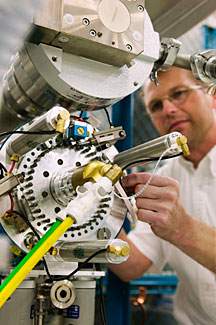- Number 374 |
- October 22, 2012
Cold cases heat up through Lawrence Livermore approach to identifying remains

Bruce Buchholz loads a sample in
the accelerator.
In an effort to identify the thousands of John/Jane Doe cold cases in the United States, a Lawrence Livermore National Laboratory researcher and a team of international collaborators have found a multidisciplinary approach to identifying the remains of missing persons.
Using "bomb pulse" radiocarbon analysis developed at DOE's Lawrence Livermore, combined with recently developed anthropological analysis and forensic DNA techniques, the researchers were able to identify the remains of a missing child 41 years after the discovery of the body.
In 1968, a child's cranium was recovered from the banks of a northern Canadian river. Initial analysis conducted by investigators, using technology at the time, concluded that the cranium came from the body of a 7-9-year-old child and no identity could be determined. The case went cold and was reopened later.
The cranium underwent reanalysis at the Centre for Forensic Research, Simon Fraser University in Canada, where skull measurements, skeletal ossification, and dental formation indicated an age-at-death of approximately 4 1/2 years old. At Lawrence Livermore, researchers conducted radiocarbon analysis of enamel from two teeth indicated a more precise birth date. Forensic DNA analysis, conducted at Simon Fraser University, indicated the child was a male, and the obtained mitochondrial profile matched a living maternal relative to the presumed missing child.
The multidisciplinary analyses resulted in a legal identification 41 years after the discovery of the remains, highlighting the enormous potential of combining radiocarbon analysis with anthropological and mitochondrial DNA analyses in producing confident personal identifications in forensic cold cases dating to within the last 60 years.
"There are thousands of John Doe and Jane Doe cold cases in the United States," said Livermore scientist Bruce Buchholz, who conducted the radiocarbon analysis in the case. "I believe we could provide birth dates and death dates for many of these cases."
Age determination of unknown human bodies is important in the setting of a crime investigation or a mass disaster, because the age at death, birth date and year of death, as well as gender, can guide investigators to the correct identity among a large number of possible matches.
Using the Laboratory's Center for Accelerator Mass Spectrometry, Buchholz determined that the radioactive carbon-14 produced by above-ground nuclear testing in the 1950s and 1960s remains in the dental enamel, the hardest substance in the body. The radiocarbon analysis shows that dating teeth with the carbon-14 method estimates the birth date within one to two years.
Above-ground testing of nuclear weapons during the Cold War (1955-1963) caused a surge in global levels of carbon-14 (14C), which has been carefully recorded over time. The radiocarbon technique determines the amount of 14C in tooth enamel. Scientists can relate the extensive atmospheric record for 14C to when the tooth was formed and calculate the age of the tooth and its owner.
In forensic cases where teeth are unavailable, the radiocarbon analysis of bone also can provide useful information whether the time of death occurred prior to 1955 or afterward.
In the missing child case, Buchholz determined radiocarbon values for two teeth, which once analyzed showed that that the average of the crown's enamel formation span occurred between 1959 and 1961.
"In a conservative estimate, the carbon-14 value for the crown's enamel would correspond with a birth year between 1958 and 1962," Buchholz said.
In summary, the 14C dates in combination with the age-at-death estimate using anthropological techniques suggest that the child was born between 1958 and 1962 and died between 1963 and 1968.
The research also has implications for the identity of victims in mass graves or mass fatality contexts, where a combined DNA and radiocarbon analysis approach provides the additional benefit of distinguishing between maternal relations.
Besides Livermore and Simon Fraser University, other institutions participating in the research include the Karolinska Institute in Sweden and the British Columbia Institute of Technology.[Anne Stark, 925.422.9799,
stark8@llnl.gov]
